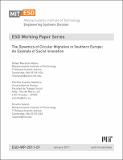The Dynamics of Circular Migration in Southern Europe: An Example of Social Innovation
Author(s)
Maranon-Abreu, Rafael; Caballero, Estrella Gualda; Valerdi, Ricardo
Downloadesd-wp-2011-01.pdf (2.600Mb)
Metadata
Show full item recordAbstract
During economic crises, governments establish policies that facilitate the creation of jobs, goods and services that make their economies more resilient. Often, this requires innovative social programs that match global migratory trends to local labor demand. The implementation of such programs requires a significant degree of innovation that requires models that can capture the complexity involved. To explore this phenomenon, we provide a multi-disciplinary view of innovative social programs that shed light on the dynamic characteristics of the political, social, technological and economic aspects of circular migration. Our focus is a case study of the European Union-funded circular migration program to support the strawberry harvest in the province of Huelva in Spain. Covering the time period of 1999-2011, this paper provides a system dynamics model to represent the key elements that led to the success of circular migration from the standpoint of economic and social change. The model helps explain the key factors that make the program robust under recent economic crisis conditions. Based on a qualitative analytical approach, the model demonstrates how adaptive policies can enable macroeconomic equilibrium in environments where circular migration can be implemented. We also show that circular migration is not an impediment to economic recovery, in fact, it helps stabilize the labor supply in times of high uncertainty.
Date issued
2011-01Publisher
Massachusetts Institute of Technology. Engineering Systems Division
Series/Report no.
ESD Working Papers;ESD-WP-2011-01